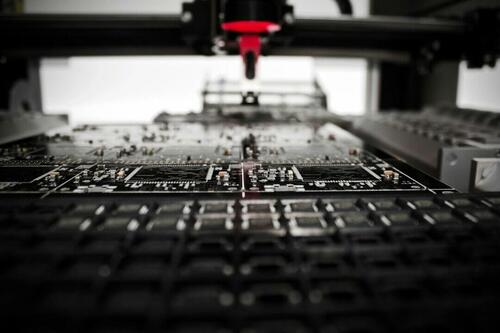Authored by Douglas French via The Mises Institute,
For lending, as in all things, necessity is the mother of invention. No matter the rate, lenders want to lend and borrowers want to borrow, with both sides tending to overdo it.
The Wall Street Journal (WSJ) reports that the newest collateral thing is the artificial intelligence (AI) chip. Wall Street heavyweight Blackstone led a $7.5 billion round of financing at the end of May for CoreWeave, “a New Jersey-based startup that owns artificial-intelligence chips and associated computing gear in data centers.”
The collateral of the realm these days is Nvidia’s graphics-processing unit, or GPU, chip. For the moment, Nvidia can’t keep up with demand from the likes of Amazon and Microsoft. These companies are gorging themselves on the chips, sending GPU chip prices skyward.
“For Wall Street, their utility has given them another kind of power, turning them into assets that can backstop loans,” Asa Fitch and Miriam Gottfried wrote for the WSJ.
More than $10 billion has been raised using GPU chips as collateral. Startups in the AI space, while growing quickly, are not profitable. Thus, loan interest rates are in the low double digits as traditional lenders, which charge lower rates, have avoided the sector. Instead, asset-based lenders, which small businesses and real estate developers have typically had to turn to are providing capital for this high-flying technology niche.
“When you’re trying to build and scale a company at the speed that we’re going, it is access to capital that defines success or failure,” Michael Intrator, CoreWeave’s CEO, told the WSJ.
Over time, he hopes his company can obtain cheaper funding.
However, for now, “it gets us what we need, which is the powder to be able to move at this size and scale.”
Mr. Fitch and Ms. Gottfried describe the deal structure as “a metaphorical lockbox, housing all of CoreWeave’s AI chips,” with all “revenue the company generates from clients using those chips ... [going] first toward paying its lenders.” Most accounts-receivable factoring structures work much the same way. However, the term “metaphorical lockbox” will make a veteran lender scoff.
“When I started doing this, everybody thought I was nuts. Now people are starting to see the light,” said Stéphane Fisch, a principal at Argo Capital who has pitched one such deal.
At the retail investor end of the AI boom, lending and borrowing continues apace. Almost Daily Grant’s reports that the people’s brokerage, Robinhood, has cut margin lending rates to “6.75 percent financing on balances up to $50,000, with that rate dropping to 5.7 percent on accounts of $50 million and above.” The favorite of millennials and Gen Zers previously was made to pony up margin loan rates ranging from 8 percent to 12 percent. Rival brokerage Charles Schwab offers much stiffer rates of 11.83 percent to 13.58 percent.
For readers wondering when the next market accident is about to happen, Robinhood Chief Brokerage Officer Steve Quirk may be offering a clue when he told MarketWatch: “People use [margin investing] episodically when they see a great opportunity or love a specific investment. But I think where the opportunity lies is, in addition to our current customers, we’re seeing a whole lot of new customers that are more frequent margin users with larger balances.”
Almost Daily Grant’s warns us:
“Aggregate margin debt outstanding registered at $775.5 billion at the end of April according to FINRA. That’s up 23 percent from the year-ago period and equivalent to 2.8 percent of 2023 GDP, roughly matching the output-adjusted figure logged at the peak of the late 1990s dot.com bubble.”
Those numbers are no match for the $936 billion reached in the fall of 2021, equivalent to 3.43 percent of the GDP.
Of course, lending and borrowing success depends on the strength of the AI boom.
For the moment, the demand for AI chips appears insatiable.
At the same time, big tech companies and startups can’t seem to generate enough revenue from AI to justify the cost of the computing power that underlies it—a story that sounds very familiar.
